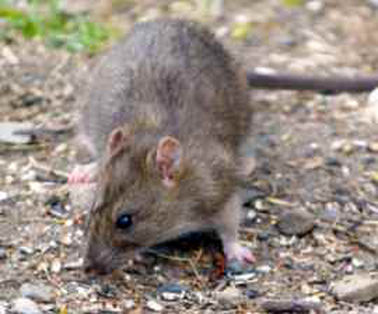Rats are incredibly hardy animals who have never shown any problem adjusting to change. Usually that change is the introduction of a new poison, as humans constantly work harder and harder to exterminate these animals. But perhaps no other animal resists such attempts better than the rat.
Rather than looking for more powerful and potentially dangerous ways to kill rats, the only real answer to people’s conflicts with these animals is to alter the habitats in which they choose to live to make them less attractive and acceptable.
Common problems and solutions
-
Tolerance
-
Identifying rat signs
-
Keeping rats out
-
Repellants
-
Modifying habitat
-
Lethal control
Common conflicts and solutions
Food: Rats will eat anything a human will, and more. But worse damage is done by their urine and feces which are left behind on any uneaten food.
Burrows: Although rats may create damage with their borrowing, it’s usually more superficial than structural.
Chewing: Since their front teeth grow all their lives rats, chew on things to keep them worn down. This can be dangerous when they gnaw on electrical wiring.
Public Health: Rats can carry many diseases that are harmful to people.
Tolerance
Tolerating rats is not something many people want to do. For many reasons people and rats are unlikely to coexist peacefully. But coexist we will, as perhaps more than any other wild animal, rats have adapted to living among humans. That we do not generally tolerate their presence does not mean that we need to use dangerous and inhumane methods to destroy them—or accept a no-holds-barred way to controlling their numbers.
The best way to control rats is to discourage them from taking up residence in the first place. Typically, conditions that support high rat populations are left until there is a real crisis at hand. Then the poisons are used or trapping employed to reduce the population, only to leave unaddressed the cause of the problem in the first place. Any effort to limit rat populations must be followed by taking the necessary steps—exclusion and sanitation—to make sure the same problems never happen again.
Identifying rat signs
Inside
-
Droppings.
-
Gnawed holes up to two inches wide in baseboards or at doorframes (indicates they’ve been there a while).
-
Smudge marks (body oils) on walls.
-
Sounds of movement in walls and attics.
-
The family pet staring intently at a blank wall.
Outside
Burrows may indicate the presence of rats, but could also indicate other burrowing animals such chipmunks. Never attempt to control a wildlife problem without being sure what species of wildlife you are dealing with.
To find out if the burrow is in current use, loosely fill it with soil or leaves and check it in a day or two to see if it has been reopened.
Keeping rats out
Rats can enter buildings through many openings:
-
Holes as small as 1 inch wide (about the size of a quarter).
-
Heating vents.
-
Gaps anywhere electrical conduits, utility or air conditioning lines, or water pipes enter a building.

